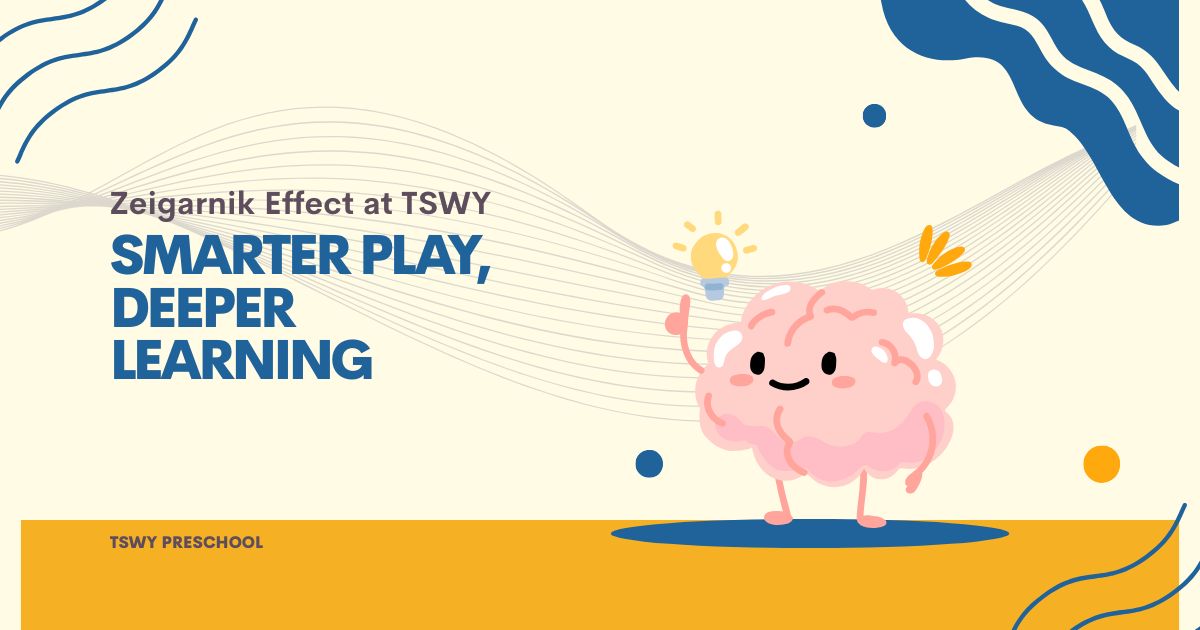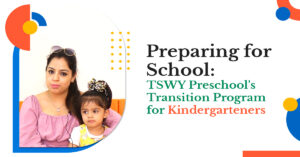Perhaps in the world of education, particularly early childhood education, new methods and approaches are constantly being developed and discarded. From time to time, there are timeless psychological concepts that shape the way our children learn—one that comes to mind is the Zeigarnik effect.
Zeigarnik is a theory that can substantially improve our approach to engaging children’s brains in our preschools. When paired with play-based learning, it becomes a wonder duo. Zeigarnik increases memory, curiosity, creativity, and advanced learning applications.
In this blog, we’ll discuss:
- What the Zeigarnik Effect entails.
- Its relevance in early childhood education.
- Real classroom and home scenarios.
- Every day, strategies to apply during play.
- Why it works from a neuroscience perspective.
In the following, we explore how leaving things unfinished can foster a child’s most wholesome learning moments.
What is the Zeigarnik Effect?
The Zeigarnik Effect is a psychological principle named after Bluma Zeigarnik, a Soviet psychologist who discovered that individuals are more likely to remember tasks that are uncompleted and interrupted rather than tasks that are completed. Her study showed that interruptions during a task help people retain information better because their brain is trying to resolve an unfinished ‘loop’. Until that ‘loop’ is determined, the mind remains engaged.
That untapped potential—the need to finish what’s incomplete— is what causes the brain to remain alert, which in adults manifests in the form of obsessive, unresolved emails. In the case of children, the brain uses this as a gateway to boundless curiosity and self-driven learning.
Why the Zeigarnik Effect is a Game-Changer in Early Childhood Education
The early years of a child’s life are arguably the most important for cognitive and emotional growth. During this time, a child’s brain is highly plastic, rapidly forming new connections, building memories, and reacting to stimuli.
The Zeigarnik Effect in early childhood education plays a unique role here.
Here’s Why:
Children’s curiosity and love for solving mysteries make going after unfinished tasks something unusual, and it sparks their interest. So, children’s interest is sustained, and longer attention spans are also observed. Please consider how children maintain their focus on incomplete puzzles.
They learn better when the method of learning is integrated into a ‘discovery’ approach. When children are given the chance to explore, it inspires confidence and independence.
Young learners’ brains remain receptive and are actively processing during some cognitive tasks, resolving, figuring, answering, and encoding knowledge into long-term memory. This supports the concept of play-based learning at preschool, where guided discovery, open-ended play, and free exploration support learning.
Play-based Learning in Preschool: The Ideal Match
At preschool, playful learning remains structured around the curriculum in a game-based format. It offers a developmentally suitable framework that balances the social, emotional, cognitive, and physical development.
The “sage on the stage” paradigm, where the teacher dispenses knowledge and children passively listen, does not apply in this setting. Children engage with the curriculum and with each other through inventing, discovering, and building, and therefore are the center of the learning process.
Now, combine this with the Zeigarnik Effect.
Imagine a preschooler making a block castle. A teacher gently interrupts midway, offering a break with, “Let’s take a break, and I wonder how the rest of the castle might look tomorrow?” To that child, they remain focused on completing the castle. Upon return, that child is fully intent on finishing the imagined parts. During snack, storytelling, and even at home, that’s learning that stays.
Real Applications of the Zeigarnik Effect in Early Childhood Learning Activities
Put theory into action. Here are some examples that illustrate the Zeigarnik Effect in action in the preschool and home settings.
- Incomplete Stories
Read stories to preschoolers. The last few sentences should be left hanging.
Prompt: “So what happens next?”
This supports language development, storytelling, and creative thinking. It also helps in remembering the story and predicting plausible endings, which utilizes imagination.
- Incomplete Drawings
Invite learners to build on work that has already been started. Give them pre-drawn pictures that are not filled in.
Prompt: “This flower isn’t fully drawn. It’s missing something. What’s that?”
This helps in the development of refined motor skills, visual and spatial skills, and creative thinking.
- Puzzles or Games that are Deliberately Stopped
Do half of a puzzle or game and stop.
Prompt: “Let’s stop here for today. What do you think goes here?”
Without their active presence, their brains will be in the background figuring out the rest of the things.
- Stop Obstacle Courses
Let the learners think on their own. They only think of the strategies required to finish the tasks you give them.
Prompt: “This bridge is half built. What will you do to finish the rest of it?”
How This Strengthens Important Learning Outcomes
In preschool, all domains of learning are integrated. Here’s how the Zeigarnik Effect benefits different areas of development:
| Development Area | Potential Benefits |
| Cognitive Skills | Enhanced retention of information, memory recall, problem-solving, critical thinking, and analysis |
| Language & Communication: | Story retelling, sequencing, and prediction skills |
| Social & Emotional Skills: | Patience, teamwork, interest-driven dialogue, inquiry |
| Creative Thinking: | Inventing conclusions, imaginative drawing, and abstract motor play |
| Physical & Motor Skills: | Fine motor skills from puzzles, block play, and art activities |
Thus, the Zeigarnik Effect profoundly applies to the principles of preschool teaching, making it possible not only to support various learning skills but also to mesh seamlessly within the play-based learning curriculum.
What evidence is available to support this claim?
Task interruption allows the child’s brain to “pause” and consider unfinished work, so the task remains engaged within their cognitive working memory. This is not “completed,” so the brain continuously tries to go back to the task.
Every time the child nears completion of the task, the approach/interaction brings them closer, so it activates dopamine, and each step provides satisfaction, motivation, and delight.
It also strengthens executive function, which enables the brain to mentally age, recall, organize, and complete tasks over time, skills that are blended seamlessly.
Suggestions for Parents and Teachers: Implementation at Home or in School
There is no need for expensive resources or elaborate teaching techniques in the Zeigarnik Effect teaching strategies. Instead, it is simplicity that makes it practical and beautiful.
✅ DOs:
- Teach with “cliffhanger” storytelling.
- Pause for Effect, but not due to boredom or distraction.
- Encourage, “What next?” or “What would you do?”
- Let discovery happen without guidance.
- Encourage process-focused outcomes.
❌ DON’Ts:
- Do not leave work half-finished to the point where it elicits frustration.
- Do not micromanage during free play—the Effect is diplomatic and it prefers spontaneity.
- Do not overlook when children engineer “unfinished moments.”
Bringing the Zeigarnik Effect to Life at TSWY Preschool
At TSWY preschool, the educational philosophy of “Wonder. Imagine. Discover,” serves as a guide for our curriculum. We integrate play with the latest psychological findings, enabling children to navigate the world joyfully.
The Zeigarnik Effect is integrated into:
- Our storytelling sessions involve unfinished tales.
- Our “pause and play” areas have projects that children revisit each day.
- Our workshops are aimed at art creation, where unfinished pictures stimulate collaborative creation.
- Our daily challenges ignite child-initiated learning.
- Our intent is not to propel children toward some predetermined conclusion, but rather to welcome them into a world of “what if?”
Final Thoughts: Embracing Incompleteness Through the Zeigarnik Effect
Children remind us that the most enriching experiences of learning occur in a state of wonder and not in a state of closure in a world that often values speed and instant results.
The Zeigarnik Effect in early childhood education shows that children can learn effectively even when activities don’t conclude. The most effective way to engage a child is to leave the most open endings.
The next time you’re reading to your child, building a fort, or solving a puzzle together.
Pause.
Ask:
“What do you think is next?”
Then, they observe the spark in their imagination.
Looking To Get More Ideas Like This?
At TSWY Preschool, we not only offer lessons but also motivate. Through the combination of neuroscience, play, and parental collaboration, we support each child’s learning journey.
- You can always visit www.tswyprreschool.com for additional resources.
- Check us out on Instagram for weekly ideas and tips for parents: https://www.instagram.com/theshriramwy?igsh=NWpvZDk4aHJmbHhl
- Learn it with us. Try it at home.






Such a creative take on how unfinished play can spark curiosity and deeper learning in young minds — really makes you appreciate the magic behind play-based exploration! Love how this highlights that asking “what’s next?” can strengthen memory and engagement in little learners.